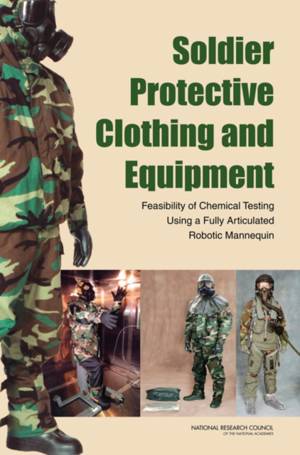
- Afhalen na 1 uur in een winkel met voorraad
- Gratis thuislevering in België vanaf € 30
- Ruim aanbod met 7 miljoen producten
- Afhalen na 1 uur in een winkel met voorraad
- Gratis thuislevering in België vanaf € 30
- Ruim aanbod met 7 miljoen producten
Zoeken
Soldier Protective Clothing and Equipment
Feasibility of Chemical Testing Using a Fully Articulated Robotic Mannequin
National Research Council, Division on Earth and Life Studies, Board on Chemical Sciences and Technology, Committee on Full-System Testing and Evaluation of Personal Prot
Paperback | Engels
€ 82,95
+ 165 punten
Omschrijving
There is an ongoing need to test and ensure effectiveness of personal protective equipment that soldiers use to protect themselves against chemical warfare agents. However, testing using human subjects presents major challenges and current human-size thermal mannequins have limited testing capabilities. The U.S. Department of Defense (DOD) along with their counterparts from other countries are seeking to develop more human like mannequins, which would include features like human motion, in order to carry out more advanced chemical testing. At the request of DOD Product Director, Test Equipment, Strategy and Support, the National Research Council formed an ad hoc committee to evaluate the feasibility of developing an advanced humanoid robot, or Protection Ensemble Test Mannequin (PETMAN) system that meets the DOD requirements. The book concludes that although most of the individual requirements can technically be met, fulfilling all of the requirements is currently not possible. Based on this conclusion the committee recommends that DOD considers three issues, prioritization of current system requirements, use qualified contractor for particular technical aspects, incorporate complementary testing approaches to the PETMAN system.
Specificaties
Betrokkenen
- Auteur(s):
- Uitgeverij:
Inhoud
- Aantal bladzijden:
- 170
- Taal:
- Engels
Eigenschappen
- Productcode (EAN):
- 9780309109338
- Verschijningsdatum:
- 19/04/2008
- Uitvoering:
- Paperback
- Formaat:
- Trade paperback (VS)
- Afmetingen:
- 155 mm x 231 mm
- Gewicht:
- 290 g

Alleen bij Standaard Boekhandel
+ 165 punten op je klantenkaart van Standaard Boekhandel
Beoordelingen
We publiceren alleen reviews die voldoen aan de voorwaarden voor reviews. Bekijk onze voorwaarden voor reviews.








